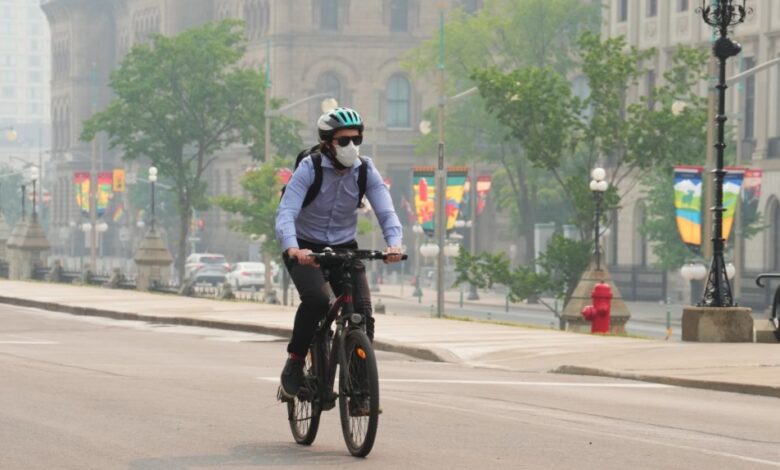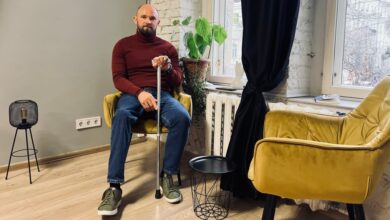Parents calling for better air quality at schools

Kate Laing’s family managed to avoid COVID-19 for more than two years.
When her oldest son went back to school last year, she said it only took three days for him to become infected and bring the virus home.
“He was masked, but he had to take his mask off to eat his lunch,” Laing said. “He’s sitting at a table with four other kids and one of them had COVID.”
Laing believes that’s the most likely source of his COVID-19 infection, and that cleaner air could have helped prevent it while the kids were unmasked.
Her son, now nine, has asthma which flares up when he gets sick. His younger brother, now almost three, also became infected and got very ill.
“We had gone without family, we had gone without friends, we had gone without everything. My youngest wasn’t even in daycare yet,” said Laing, who lives in Wilmot Township in the Waterloo, Ont., region.
“I was — I think, fairly understandably — really annoyed that this had been the situation that my family had been put in.”
Laing found other concerned parents, including an epidemiologist, who had formed a group called Ontario School Safety. She volunteered to help and is now the group’s chair.
It’s one of several grassroots groups of parents, health-care workers and teachers that have sprung up across Canada to lobby for safer schools, including improved air quality. Although protecting students and education workers against COVID-19 was the main driver when they started, other viruses such as flu and RSV — plus wildfire smoke and other air pollutants — have also become key concerns in the quest for cleaner air in classrooms.
“A lot of us got, you know, ‘armchair degrees’ in mechanical and ventilation engineering to try to understand what the crux of the problem was and how we might start addressing some of these things. And it became clear that indoor air quality is about so much more than just COVID-19,” Laing said.
Amanda Hu, spokesperson for parent advocacy group Fresh Air Schools Alberta, agreed.
“It’s been a struggle because the things that we’ve pushed for during COVID that have only become more important when we have (this) confluence of air quality issues, have still not been done,” Hu said.
One of the most effective ways to protect kids and teachers against the dual threat of viruses and polluted air is better ventilation coupled with air filtration, parent groups and air quality experts say.
“The no-brainer that works in every school is a good portable filter in every space that’s sized appropriately for the space,” said Jeffrey Siegel, a civil engineering professor specializing in air quality at the University of Toronto.
Those can be HEPA — high efficiency particulate air — filters, Siegel said.
But well-constructed do-it-yourself units using a box fan and four good furnace filters also work, he said. They’re often referred to as “Corsi-Rosenthal boxes.”
“The important thing is to have a decent filter that’s moving a lot of air in the space,” Siegel said.
Although HEPA filters provide the highest quality of filtration, the do-it-yourself versions are also effective if the filters used are at least MERV 13-rated, he said. MERV stands for “minimum efficiency reporting values” and is a measure of how efficiently the filter captures particles.
They also need to be sealed tightly so that all air going into the box has to pass through the filters rather than going around them.
In addition, schools can check to see if their HVAC (heating, ventilation and air conditioning) systems can be upgraded with MERV 13 quality filters, Siegel said.
But he noted that in many cases, it may be more cost effective to put a high-quality air filter in every classroom.
Roger Haskett, a father of three in Vancouver, has been fighting to put HEPA or even homemade air filters into classrooms.
He volunteers as the air quality co-ordinator with the Vancouver District Parents Advisory Council. Haskett said he sees some hope for progress now that governments are looking at ways to improve air quality in light of the growing threats from wildfire smoke.
Unlike viruses, pollution from smoke is something people can see in the air, he said, and therefore seems less “politicized” than the discussion around COVID-19 prevention in schools.
“We can fight wildfire smoke and by fighting it, we can bring clean air into the classroom, which solves a whole bunch of other problems,” Haskett said. “We’re also dealing with viruses and airborne illnesses (at the same time).”
For Siegel, a big part of the issue is how governments and school boards look at air quality in schools.
“We often think about things from the cost perspective. How much is it going to cost to put a good filter in the classroom? How much is it going to cost to upgrade the HVAC?” he said.
“The real thing we should be looking at is what’s the cost of not doing it?”
In response to an inquiry by The Canadian Press, the office of Ontario Education Minister Stephen Lecce provided a memo sent to all the province’s school boards on Sept. 5.
The memo said the province requires a standalone HEPA filter “in every kindergarten class (and) in all learning spaces in schools without mechanical ventilation and (in) mechanically ventilated spaces that are not supported by MERV-13 filters.”
Ontario has invested over $665 million to improve air quality in schools and deployed over 100,000 HEPA units, said Grace Lee, the minister’s spokesperson, in an emailed statement.
The government is also investing “nearly $30 million for the coming school year” to support measures such as installing higher-grade filters, she said.
“We expect school boards to continue using HEPA filter units and optimizing air flow with the highest quality filters in the 2023-24 school year,” Lee said.
But the Ontario School Safety group said that parents, teachers and other education workers across the province are reporting that the filters aren’t getting into classrooms — or if they do, they’re often turned off. Laing and two other members of the group said their own children do not have HEPA filters in their classrooms.
Part of the problem could be a lack of education for teachers about the importance of the classroom air filters and how to use them to get maximum benefit, as well as troubleshooting, Siegel said.
His own daughter excitedly told him that there was a HEPA filter in her classroom, he said.
“I asked her about it, you know, two or three days later and she said, ‘oh yeah, yeah, it was too noisy. We turned it off.”‘
Issues like noise can be easily fixed, Siegel said. For example, instead of running one big HEPA filter for the whole classroom, he suggested using a couple of smaller, strategically placed HEPA filters, such as one by the teacher and one in the middle of students’ desks.
That’s because the noise is usually caused by the amount of air being moved, Siegel said.
In Alberta, there doesn’t appear to be any direction on the use of HEPA filters in schools from the provincial government.
The Edmonton public school board adopted HEPA filters while the Calgary public school board did not, said Hu of Fresh Air Schools Alberta.
A recent back-to-school notice posted on the Edmonton Public Schools website said there are “portable air filtration (HEPA) units for every classroom and learning space.”
In an emailed statement, the Calgary Board of Education said, “all CBE schools are mechanically ventilated and systems are set to maximize air exchange.”
The board upgraded to MERV 13 filters on its ventilation equipment “whenever possible,” the statement said
“With these measures in place, the CBE’s position regarding portable air cleaning devices remains unchanged at this time,” it said, noting the board is “fully compliant with all provincial direction and legislated requirements.”
Hu, who lives in Calgary, started fighting for better air quality in public schools when her daughter was two years old, “because I thought that maybe we’d get traction (by) the time she started kindergarten.”
Her daughter is now five and Hu drives her half an hour each way to a private school that has adopted air filtration.
“That is not fair and that’s not equitable for kids who go to public school (in Calgary),” she said.
Although both education and health fall under provincial jurisdiction, Health Canada is “currently developing new indoor air quality guidance for schools in Canada,” a spokesperson said in an email.
“It will provide recommendations and best practices for improving indoor air quality in schools, including improving ventilation and filtration, based on the latest science and information available.”
A draft of that guidance is expected to be available for public comment next spring or summer, Health Canada said.
This report by The Canadian Press was first published Sept. 12, 2023.




